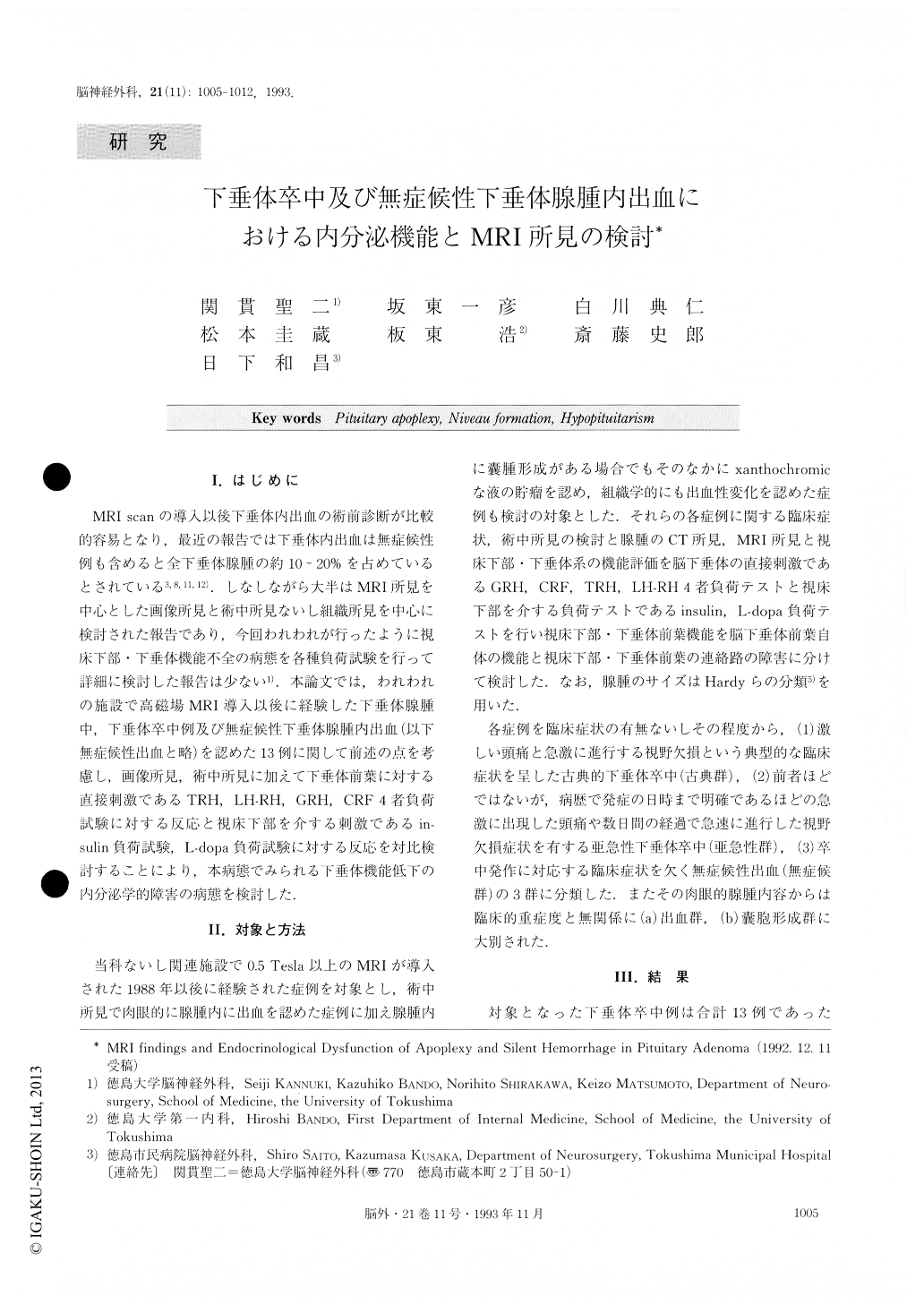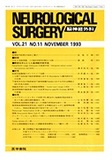Japanese
English
- 有料閲覧
- Abstract 文献概要
- 1ページ目 Look Inside
I.はじめに
MRI scanの導入以後下垂体内出血血の術前診断が比較的容易となり,最近の報告では下垂体内出血は無症候性例も含めると全下垂体腺腫の約10-20%を占めているとされている3,8,11,12).しなしながら大半はMRI所見を中心とした画像所見と術中所見ないし組織所見を中心に検討された報告であり,今回われわれが行ったように視床下部・下垂体機能不全の病態を各種負荷試験を行って詳細に検討した報告は少ない1),本論文では,われわれの施設で高磁場MRI導入以後に経験した下垂体腺腫中,下垂体卒中例及び無症候性下垂体腺腫内出血(以下無症候性出血と略)を認めた13例に関して前述の点を考慮し,画像所見,術中所見に加えて下垂体前葉に対する直接刺激であるTRH, LH-RH, GRH, CRF4者負荷試験に対する反応と視床下部を介する刺激であるin—sulin負荷試験,L-dopa負荷試験に対する反応を対比検討することにより,本病態でみられる下垂体機能低下の内分泌学的障害の病態を検討した.
Magnetic resonance image (MRI) findings, intraopera-tive macroscopic findings and endocrinological functions were reported in 13 cases of hemorrhagic pituitary ade-noma (HPA) according to clinical severity. The cases were divided into 3 groups : (1) classical pituitary apo-plexy (PA) (n=2), (2) subacute PA (n=9), (3) asymp-tomatic HPA (n = 7). Based on MRI intensity and in-traoperative findings, there were 7 cases with hemorrha-gic PA and 5 with necrotic cyst formation. MRI intensi-ties predicted the cyst contents, either hemorrhagic or xanthochromic, more accurately than CT findings. In addition, two classical cases of the PA group disclosed niveau formation on MRI, but MRI intensity in the first case differed from that in the second case. Classical PA of the first case occurred during the pregnancy. MRI in-tensity in the case 7 months after the onset disclosed high intensity of the upper part and normointensity of the lower part. T1 weighted image and proton image showed homogeneous intensity. On the contrast, PA of the second case showed water-like intensity on the upper part and methemoglobin-like intensity on the lower part. These different MRI intensities suggest different etiolo-gies of niveau formation. MRI findings in the first case may indicate the chronic stage of massive intratumoral hemorrhage but the mechanism may be the same in both cases. From MRI intensity and clinical course, the cause of niveau formation in the second case is similar to that found in the literature. That is, hemorrhage was thought to have occurred in the pre-existing cyst cavity. Hormonal loading tests were divided into two groups : group A as direct stimulation against the anterior pituit-ary gland (GRH against GH, LHRH against LH and FSH, TRH against thyroid hormone and CRF against ACTH) and group B as indirect loading stimulation via the hypothalamus (insulin-hypoglycemia test and L-dopa loading test). Hypofunction was observed in 6 of 8 cases in the gonadotropic system and 7 of 8 cases in the GH system. In contrast, only one case showed hypofunction in the ACTH-cortisol system. Hypopituitarism had occurred at the first gonadotropic hormone and growth hormone. In addition, some cases showed results in which there were differences between direct and indirect loading test for GH. 3 among 6 cases with low response against indirect GH loadind test showed normal response in direct GH loading test. In a word, disturbance of the connection between hypothalamus-anterior pituitary gland, or stalk of the pituitary gland, is suspected in these three cases.

Copyright © 1993, Igaku-Shoin Ltd. All rights reserved.


